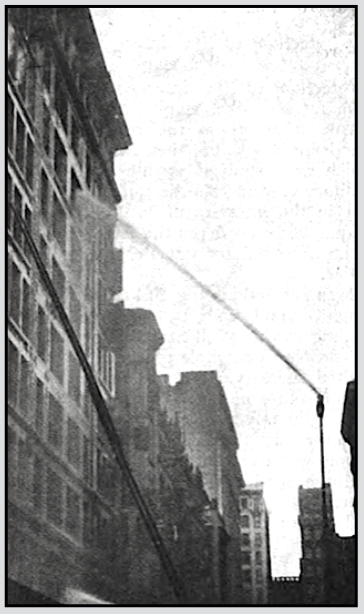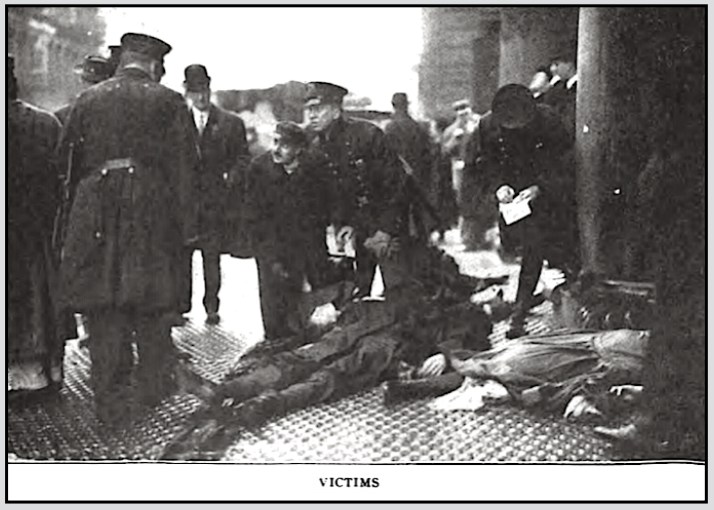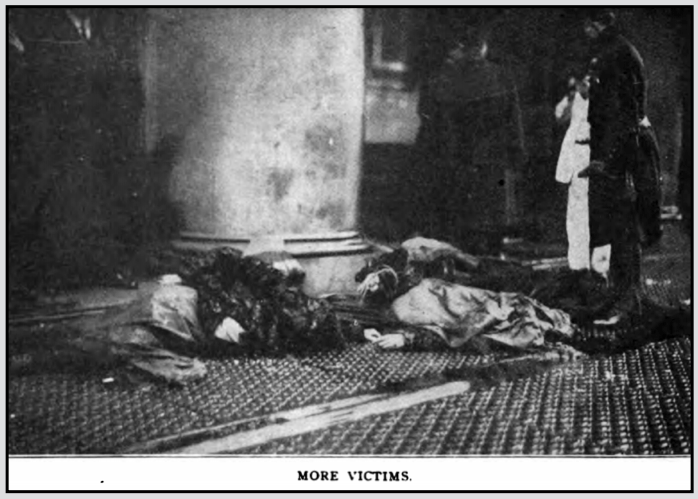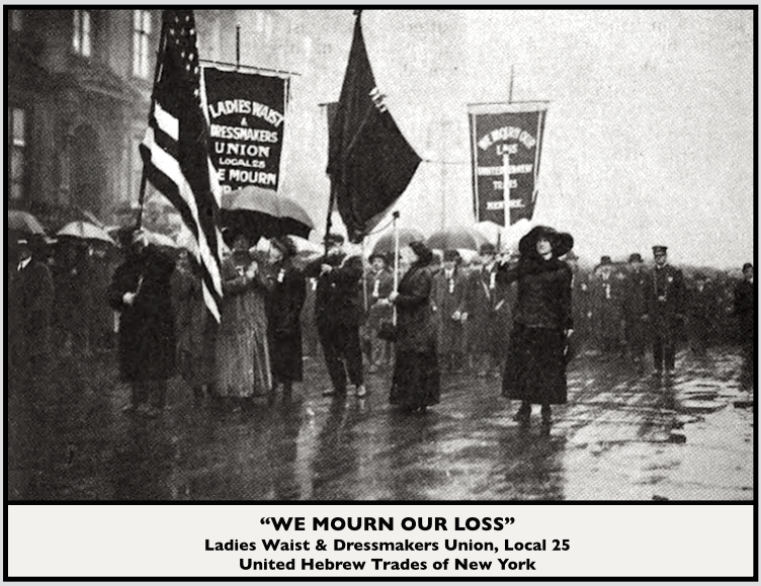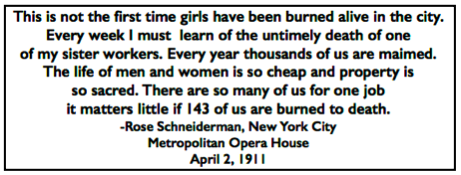 —————
—————
Hellraisers Journal – Wednesday May 3, 1911
Louis Duchez on Murder of Shirtwaist Makers in New York City, Part I
From the International Socialist Review of May 1911:
THE MURDER OF THE SHIRT WAIST MAKERS
IN NEW YORK CITYBY LOUIS DUCHEZ
Photographs by American Press Ass’n.
[Part I of II.]
TRUTH is, indeed, stranger than fiction.
As I write this story of the bold, brutal and cold-blooded murder of one hundred and twenty-five [129] girls, averaging nineteen years of age, and twenty [17] men, here in New York, I wonder if what I have seen and heard and felt is real.
It was Saturday evening, March 25. Only five minutes more and the slaves at the sewing machines would be hurrying to their “homes,” carrying their starvation wages for the week. More than 500 of them were employed by the Triangle Waist Company, the non-union concern which led the fight on the shirt waist girls more than a year ago. The slave pen was located on the eighth, ninth and tenth floors of a “fire proof” building in the very heart of the congested section of the city.
In some corner unknown on the eighth floor highly inflammable materials caught fire. Before anyone had time to look around big tongues of flame were licking up everything in the room.
A general rush was made for the elevators and stairways. The elevators did their best, but during the few minutes in which the tragedy occurred only fifty girls were lowered.
The stairways were the principal ways of escape—and the doors leading to these stairways were locked. For it was the custom of this firm, as it is the custom in other shirtwaist factories in New York, to lock the doors after work begins in the morning and to keep them locked all day, so that the employes may be searched before going home for pieces of goods, thread or buttons, and so that they may be prevented from going out and “stealing time” during the day.
Everywhere throughout the three floors silk and cotton goods hung from racks or were piled up on tables, and the little blaze which started in the unknown corner was like a spark in a powder magazine. In ten minutes the three floors were all afire. Huge clouds of flame belched from nearly every window.
Finding the doors locked to the stairways, the girls rushed to the windows. With their hair and clothes afire, they leaped from the eighth, ninth and tenth story windows. Some were seen climbing upon the sills and deliberately plunging to the pavement. Others, it is said, were pushed out by the pressure behind. In one instance two girls came down from the ninth story in each other‘s arms. Others were seen embracing and kissing each other before making the fatal leap.
One man, excited and perhaps realizing that they would all be burned to a crisp if they remain in the building a few minutes longer, anyway, picked up six girls one after another, and threw them out the window of the ninth story, after which he plunged to his death, also.
At the height of the fire, when all the girls had either been burned to death in the building or had leaped to the pavement, two young women, about seventeen, stood out on the ledge of rock which marked the tenth story. They were both facing the wall and embracing each other. Apparently one was attempting to prevent the other from jumping, but the latter broke away and threw herself off the ledge with a shriek. A few moments later the lone girl raised her hands above her head, looked upward, then shot feet foremost off the ledge to the street upon the already large pile of burned and mangled human flesh and bones.
One girl, after falling six stories, was rescued from a large hook beside a window at the third story, where she was hanging by her clothes, face downward. Another saved herself by leaping on top of the elevator roof and grabbing the cable as it passed the eighth floor.
Below, the sight was sickening. Thousands of people had gathered and the fire men were doing their best to save as many lives as possible. Nets were spread and even horse blankets used in an effort to catch some of the falling bodies. But the nets and blankets broke under the weight of three and four bodies falling into them at the same time. Those who plunged from above did not have time or they were too excited to wait on each other or to judge correctly regarding the location of the nets. On the other hand, those in charge of the nets could do very little under the rain of bodies.
All that was left of the victims was placed in rows along the pavement, where they were tagged and numbered. Then came the rough, brown police coffins in which the remains were placed and taken to the Municipal Ferry and strung out on the clock. They were afterwards hurried to the morgue. Scores of injured were rushed to the hospitals and many died on the way.
By ten o’clock after the fire 135 bodies were discovered. Fifty were taken from a single heap five feet high where the helpless victims battered in vain at one of the locked doors leading to the stairway. Two girls were taken from an iron picket fence upon which they had fallen. Twelve others were discovered in the basement. They had plunged through the street pavement, making a hole in it six feet in diameter. All those that leaped to the street were killed instantly or died a few minutes afterwards. Those that remained in the building were burned to death. Some of the bodies were so badly burnt and torn to pieces that they had to be gathered up in blankets, tied to the end of a rope and lowered to the street.
Horrors beyond description were seen at the morgue when relatives and friends came to identify their dead. It was impossible to recognize most of them, the majority being burned or mutilated beyond identification. Many bundles of bone and dry flesh, doubtless, were taken away by hysterical relatives who, in their mad desire to get a last look at a dear one, were only too willing to believe that this or that hunk of flesh and bones was their daughter or sister. Many of the victims were identified only because of jewelry which was found on skeleton fingers, necks and ears.
The flesh on many bodies lay in blackened shreds. In several cases heads were burned off completely. Arms and legs, too, were missing. The clothes and hair had been eaten by the flames from most of them. In a large number of cases faces were flattened and skulls sunk in, as a result of striking the pavement.
The mental and physical agony resulting from this terrible murder of industrial slaves will stretch out into the years. Many a young girl perished who was the only support of her widowed mother and younger brothers and sisters. One girl was killed who, with her brother, had been sent to this country to make enough money to support a family of twelve in Russia. One woman, the only bread winner in a family, perished, leaving a husband out of work and five children. One of the children lost a leg recently and another is now sick. Scores of such incidents could be related.
The Women’s Trade Union League planned for a parade and the burial of the unidentified victims on Monday, the second day after the fire. But the city officials refused to turn over the bodies and forbade the parade. Feeling among the workers in the city had been stirred to a high pitch, and the masters thought it would not be a healthy thing for them to permit the parade so soon after the fire. So the union leaders gave in for a few days, finally deciding to parade, regardless of what the city heads decided to do, and to hold the demonstration on Wednesday, April 5th, eleven days after the fire. Seeing that the workers were in earnest, the city authorities gave in and handed over seven coffins, each containing a whole body, or what was left of it, and one coffin in which was placed a pile of bones and flesh, representing three or more victims.
Regardless of a steady rain all day the largest working class crowd that has ever turned out in New York City followed the eight coffins to the cemetery and carried banners in memory of the 145 [146] martyrs of “peaceful industry.” [Seven coffins of unidentified victims, one coffin of body parts.]
It was estimated that between 150,000 and 200,000 workers were in line, that about 300,000 mourners lined the sidewalks. and that a million wage slaves did not work during the day because of the funeral. The following account of the procession, which appeared in the Sun, an ultra-conservative supporter of Wall Street, will give a fair idea of the gigantic turnout:
Sweatshops and garment factories were empty this afternoon. The garment workers in countless numbers were marching through the wet streets to pay, after their fashion, a tribute to the 145 who met their death in the Triangle Shirtwaist fire horror.
The Sun also said the crowd was
literally uncountable because of its size and the way in which it spread through the various streets. The throng was estimated by the marshals as totaling about 150,000. Uptown in the other division of the procession was a gathering of similar if not equal magnitude. It looked as if in spite of such a slight matter as weather, the original estimate of 200,000 paraders had been exceeded.
The most striking feature of the demonstration was the enormous number of unorganized workers in line. And to the disgrace of the building trades unions in New York, with their “sacred contracts,” they did not show up.
One 80-year old woman, poorly clad and without an umbrella, tottered along for a way with the endless column. She was mother of one of the girl victims. But she was too weak to walk far. After a few blocks she faltered and would have fallen but for friends, who carried her to the sidewalk and took her home.
———-
[Emphasis added.]
~~~~~~~~~~~~~~~~~~~~~~
SOURCES & IMAGES
Rose Schneiderman Quote, NY Met Opera Hse, Apr 2,
-from Survey p84, Apr 8, 1911
https://play.google.com/books/reader?id=OrpIAAAAYAAJ&hl=en&pg=GBS.PA84
International Socialist Review
(Chicago, Illinois)
-May 1911, page 666
“Murder” by Duchez, Part I
https://www.marxists.org/history/usa/pubs/isr/v11n11-may-1911-ISR-gog-Corn-OCR.pdf
See also:
Tag: Triangle Shirtwaist Factory Fire
https://weneverforget.org/tag/triangle-shirtwaist-factory-fire/
~~~~~~~~~~~~~~~~~~~~~~~~~~~~~~~~~~~~~
“Ballad of the Triangle Fire / Bread and Roses”
-Dora Wasserman Yiddish Theatre
Lyrics by Ruth Rubin

